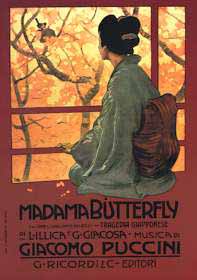|
Madama Butterfly JAPANESE TRADEDY IN TWO ACTS David Belasco's play "Madama Butterfly" left a deep impression on Puccini when he saw it in London, 1900, although the composer didn't understand English. The following year Puccini sent an Italian translation of the story to Luigi Illica and Giuseppe Giacosa with whom he convinced Ricordi to undertake this project. The work was complicated by Giacosa's health problems in May 1901 and the automobile accident in which Puccini was involved on February 25th, 1903. The maestro was confined to a wheel chair for 8 months and then he was diagnosed with diabetes, from which he would never completely recover. However, Puccini returned to composing as soon as he could. In the course of composition, he became more and more interested in all about Japan, including discussed with the wife of the Japanese ambassador about the authentic motives of Japanese folk songs, and consulted Japanese actresses on tour in Milan about the details of Butterfly's behavior. Nevertheless, the première did not enjoy the success that Puccini expected. It was a fiasco. Puccini said: "It was a real lynching. Those cannibals didn't listen to one note. What a horrible orgy of madmen, drunk with hate! But my Butterfly will not die. It is the most deeply felt and imaginative opera I have yet conceived." Immediately Puccini and his librettists started working and revising the whole opera. The second act was divided into two parts and some details were eliminated from the first one. The revised version was a great success. |
|
|
||
LIBRETTO by Luigi Illica and Giuseppe Giacosa, after David Belasco
(Madam Butterfly, 1900), John Luther Long (Madam Butterfly, 1898) and Pierre
Loti (Madame Chrisanthème, 1887). |
||
|
||
Location: Nagasaki,
Japan; Time: 1904 |
||
|
||
| PROTAGONISTS | Cio-Cio-San,
a young geisha (soprano) |
|
|
||
| PREMIÈRE | Teatro
alla Scala, Milan, February 17th 1904
|
|
|
||
| INSTRUMENTATION | 3 Fl (one also Picc), 2 Ob, Eng hn, 2 Cl, BCl, 2
Bn, 4 Hn, 3 Tpt, 3 Tbn, Tpt, BTbn Timp, Trg, Tamb, T-T, GC, Cymb, Glock (a tastiera),
Japanese Cmp, Camp, Japanese T-T , Harp, Strings; on stage: Cmp, Camt, Vla
d’amore, Bird whistles, T-T, low T-T. |
|
| CHORUS | Few Participation, just for women and tenors | |
| SYNOPSIS | ACT I: In a house in Nagasaki. Pinkerton,
an American naval officer, rents a house and plans to marry a geisha, Cio Cio San
(Butterfly), although he knows he will only be stationed there temporarily. The American
consul Sharpless, who is invited to the wedding, warns him not to trifle with Butterfly.
Cio Cio San arrives with her family. While the wedding is been celebrated the happy
atmosphere is broken by the entry of Butterfly's uncle, Bonze, who accuses Butterfly of
renouncing her family and religion. All friends and family are outraged and depart,
leaving Butterfly and Pinkerton alone. ACT II: In Butterfly's house. She has not had any news from Pinkerton for three years, but she still believes he is faithful and await his return. Sharpless gets a letter from Pinkerton that tells him that he will return with an American wife. The Prince Yamadori asks for Butterfly's hand, but in vain. When Sharpless hints that Pinkerton may not return, she is dismayed and then shows Sharpless her son. A cannon shot is heard announcing the arrival of an American ship. Butterfly recognizes Pinkerton's ship. ACT III: In the same room. Butterfly has waited for Pinkerton throughout the night. Suzuki puts her to bed at dawn. Pinkerton and Sharpless arrive and ask Suzuki to convince Butterfly to give him their son. Butterfly understands the situation at last when she sees Pinkerton's American wife, Kate. In despair, she agrees to give her son to Pinkerton an hour later. When all have departed, she bids farewell to her son and then she thrusts her father's knife into her own body and dies. |
|
|
||
| LIBRETTO | ACT I | |
| ACT II | ||
| ACT III | ||
